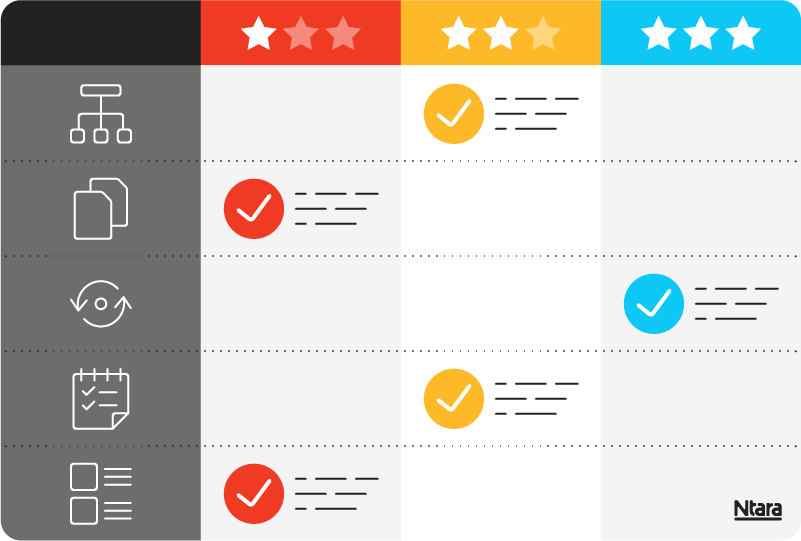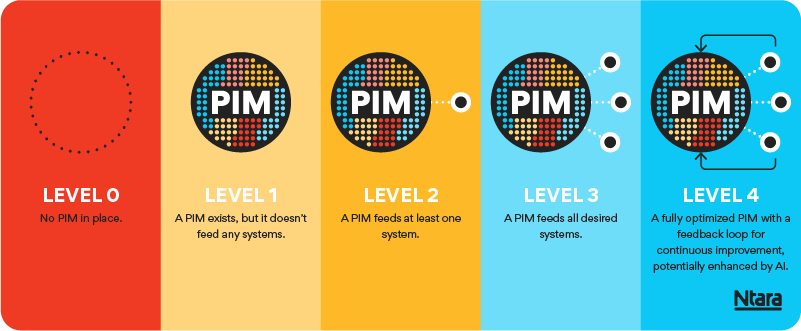Here’s a question we often get: How long does it take to implement PIM? While every project differs, certain factors slow things down while others speed the process up.

1: Your point in the PIM journey
Where you are in your PIM journey impacts timing. Are you still uncovering business needs? Evaluating PIM software against defined use cases? Or have you already selected software and need help with implementation?
No matter when we enter the process, Ntara’s goal is always to quickly deliver the foundations of a working PIM to get real, tangible feedback. This removes assumptions and minimizes rework, ensuring users and stakeholders get exactly what they need.
2: The PIM software you select
The PIM software you select can also impact your timeline. Some systems are tailored for a faster implementation right out of the box. Other systems are preferred for their ability to customize for very specific use cases and needs. Taking advantage of the flexibility in the latter is often a smart, strategic choice, but it could add time to a project.
3: The state of your data
No one starts a PIM project with perfect data—that’s often why you need PIM in the first place. However, some data issues can delay your timeline more significantly than others.
A data audit gives us a clear picture of where you stand. We use a scoring rubric to analyze factors like missing, duplicate, or inconsistent data and its potential impact.
The product data in most organizations score well enough to move forward. Occasionally, we need to account for product data remediation—which can include fixing the data upfront or transforming it during the migration process.

Pro tip: Sticking to a single character set, like ASCII, helps keep data clean as it matches easily across systems.
4: The scope of your product catalog
What do you sell, and where do you sell it? The answers shape your implementation timeline.
If you sell just one type of product, your PIM implementation is usually pretty straightforward. But the complexity grows if your catalog includes a variety of products—like beauty, clothing, and books.
For example, a book and a bottle of shampoo require entirely different product attributes, such as page numbers versus fluid ounces. While end customers need this level of detail, marketers don’t want to waste time navigating data fields that are irrelevant to them. This adds complexity we may need to address when we configure the PIM.
In the same way, selling in multiple markets with different languages, pricing, and marketing strategies adds complexity. Each market’s unique needs, such as localized descriptions or customized pricing, can extend an implementation timeline.
5: Process workflows
PIM implementation involves approvals, data clean-up, and onboarding. Sometimes, company size can make these steps take longer—especially if many people need to be involved. But more often, the real factor is the complexity of the required workflow. A company with hundreds of users may still have a short timeline if the workflow is simple, while a smaller organization with an intricate workflow may take longer to implement.
6: Number of integrations
Integrations play a major role in PIM timelines. But the challenge is often less about technical complexity and more about maintaining momentum.
When implementing PIM, you want fast time to value. This keeps stakeholders engaged and committed to moving PIM forward. What tends to cause delays is trying to scale too quickly—and integrations are a common culprit.
While your end goal may be a fully mature and connected data infrastructure, it’s still wise to take an incremental approach. Start by integrating PIM with one or two internal systems and one or two outbound connections. This approach leads to quick value, building confidence and helping you secure more resources to scale PIM over time.
Take incremental steps to PIM maturity

Overcoming delays and accelerating your PIM timeline
Delays aren’t unusual. At Ntara, we’ve seen it all. More importantly, we know what works to keep things moving—and yes, we’ve led some lightning-fast implementations. Here are some ways we’ve found to speed up the process:
- Do your homework
Gather feedback from your teams about their pain points. Document the way your systems are currently set up. Provide samples of your data to your implementation partner.
Pro tip: Don’t clean the data first! We need to see it in its rawest form to understand exactly what we’re working with. - Think through special requirements
Consider your business’s unique use cases, such as the need to automate your product catalogs or an ecommerce site that requires single sign-on. Share these details upfront to help us plan for them and avoid surprises later. - Allow time for analysis
Skipping or rushing through analysis almost always causes things to be missed, leading to costly changes later, whereas a thorough analysis gets you on the right track from the start. At Ntara, we’ll meet with you onsite to document business requirements and pain points and dive deep into the state of your data to create a solid plan.
Pro tip: Conducting an analysis also helps us give you a more informed timeline for your project. - Dedicate resources
Having the right internal resources makes a world of difference. Empower your decision-makers. Assign a dedicated PIM project manager, and ensure your various task owners know their responsibilities. Regular meetings and checkpoints keep everyone aligned while recognizing the extra effort they’re putting in beyond their day-to-day work.
Jumpstart your PIM implementation
Ntara tailors PIM implementations to your timelines and goals. When you need an extra fast start, consider our PIM Foundations offering.
This approach takes advantage of pre-existing templates to launch your PIM faster—and show value faster. From our easy-to-use discovery survey to industry-specific data model templates, we’ve created tools based on over a decade of PIM experience.
PIM Foundations is the critical first step for businesses that want to empower their teams quickly. It limits the number of integrations and configurations and answers your business needs with out-of-the-box features. It focuses on speed. It’s affordable. It’s an easier implementation for those who need PIM wins in a hurry.
To figure out which PIM implementation approach is right for you, schedule a call with a member of our team.